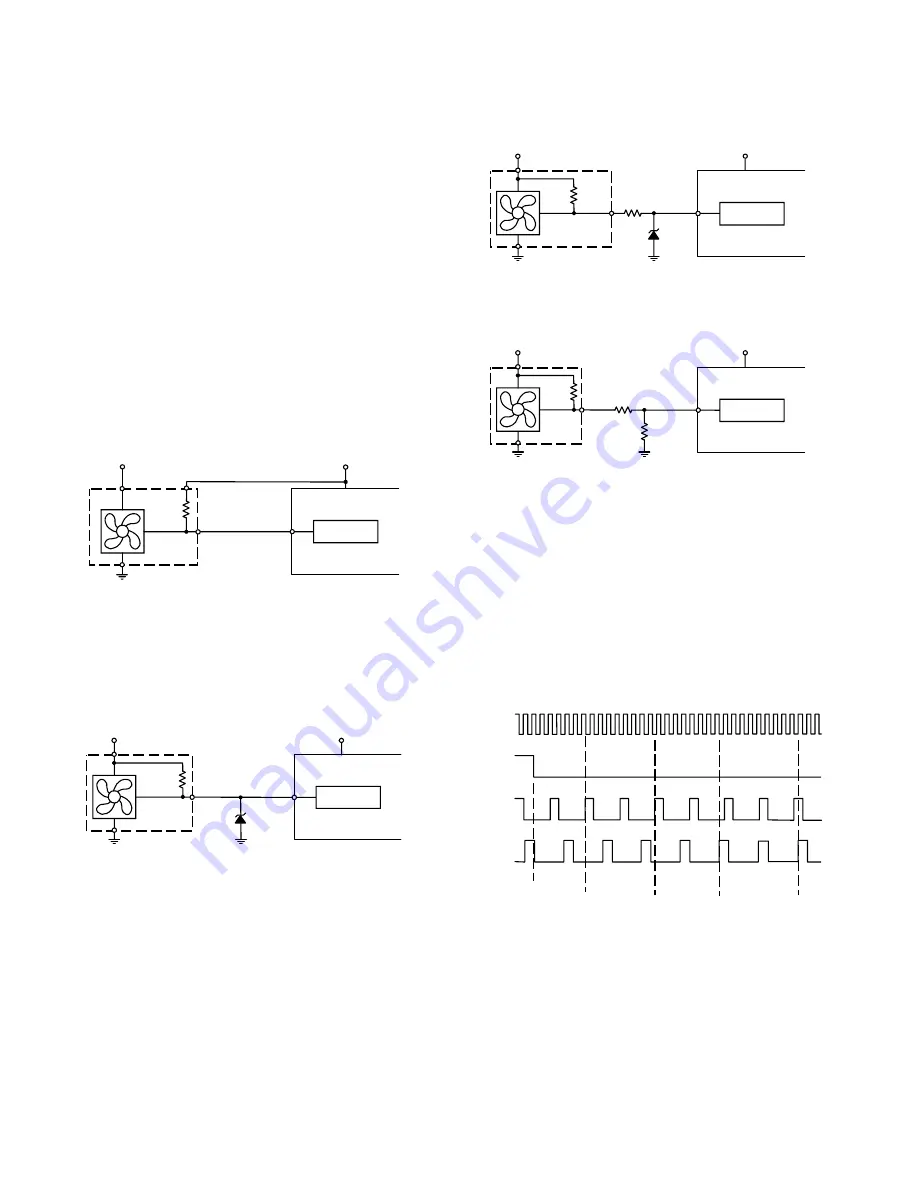
ADM1026
PRELIMINARY TECHNICAL DATA
– 2 0 –
REV. PrL
PRELIMINAR
Y
TECHNICAL
DA
TA
FAN INPUTS
Pins 3 to 6 and 9 to 12 may be configured as fan speed
measuring inputs by clearing the corresponding bit(s) of
Configuration Register 2 (address 01h) or as general-pur-
pose logic inputs/outputs by setting bits in this register.
The power-on default value for this register is 00h, which
means all the inputs are set for fan speed measurement.
Signal conditioning in the ADM1026 accommodates the
slow rise and fall times typical of fan tachometer outputs.
The maximum input signal range is 0 to +6.5V, even
where V
CC
is less than 5V. In the event that these inputs
are supplied from fan outputs which exceed 0 to 6.5V, ei-
ther resistive attenuation of the fan signal or diode clamp-
ing must be included to keep inputs within an acceptable
range.
Figures 12a to 12d show circuits for most common fan
tacho outputs.
If the fan tacho output has a resistive pullup to V
CC
then it can
be connected directly to the fan input, as shown in figure 12a.
+1 2 V
F A N S P E E D
C O U N T E R
F AN (0-7)
P ULL UP
4.7k
⍀
⍀
⍀
⍀
T YP .
T A C H O
O U T P U T
V
C C
Figure 12a. Fan With Tach Pullup To +V
CC
.
If the fan output has a resistive pullup to +12V (or other
voltage greater than 6.5V) then the fan output can be
clamped with a zener diode, as shown in figure 12b. The
zener voltage should be chosen so that it is greater than
V
IH
but less than 6.5V, allowing for the voltage tolerance
of the zener. A value of between 3V and 5V is suitable.
+1 2 V
F A N S P E E D
C O U N T E R
F AN (0-7)
T A C H O
O U T P U T
Z D 1 *
Z E N E R
P ULL UP
4.7k
⍀
⍀
⍀
⍀
T YP .
*C HO O S E Z D1 V O L T AG E AP P RO X . 0 .8 x V
C C
V
C C
Figure 12b. Fan with Tach. Pullup to Voltage >6.5V e.g.
12V) Clamped with Zener Diode
If the fan has a strong pullup (less than 1k
⍀
) to +12V, or
a totem-pole output, then a series resistor can be added to
limit the zener current, as shown in figure 11c. Alterna-
tively, a resistive attenuator may be used, as shown in fig-
ure 12d.
R1 and R2 should be chosen such that:
2V < V
PULLUP
x R2/(R
PULLUP
+ R1 + R2) < 5V
The fan inputs have an input resistance of nominally
160k
⍀
to ground, so this should be taken into account
when calculating resistor values.
With a pullup voltage of 12V and pullup resistor less than
1k
⍀
, suitable values for R1 and R2 would be 100k
⍀
and
47k
⍀
.This will give a high input voltage of 3.83V.
+1 2 V
F A N S P E E D
C O U N T E R
F AN (0-7)
P UL L UP
T Y P . <1k
⍀
⍀
⍀
⍀
O R T O T E M -P O L E
Z D 1
Z E N E R*
R1
10k
⍀
⍀
⍀
⍀
T A C H O
O /P
*C HO O S E Z D1 V O L T AG E AP P RO X . 0 .8 x V
C C
V
C C
Figure 12c. Fan with Strong Tach. Pullup to >V
CC
or Totem-
Pole Output, Clamped with Zener and Resistor
+1 2 V
F A N S P E E D
C O U N T E R
F AN (0-7)
T A C H O
O U T P U T
R 1 *
R 2 *
<1k
⍀
⍀
⍀
⍀
V
C C
*S E E T E X T
Figure 12d. Fan with Strong Tach. Pullup to >V
CC
or Totem-
Pole Output, Attenuated with R1/R2
FAN SPEED MEASUREMENT
The fan counter does not count the fan tacho output pulses
directly, because the fan speed may be less than 1000 RPM
and it would take several seconds to accumulate a reason-
ably large and accurate count. Instead, the period of the fan
revolution is measured by gating an on-chip 22.5kHz oscil-
lator into the input of an 8-bit counter for two periods of
the fan tacho output, as shown in Figure 13, so the accumu-
lated count is actually proportional to the fan tacho period
and inversely proportional to the fan speed.
22.5kHz
CLOCK
CONFIG
RE G. 1 BIT 0
FAN0
INP UT
FAN0
M E AS URE M E NT
P E RIO D
FAN1
M E AS URE M E NT
P E RIO D
S TART O F
M ONITORING
CY CLE
FAN1
INP UT
1
2
3
4
1
2
3
4
Figure 13. Fan Speed Measurement
The monitoring cycle begins when a one is written to the
Monitor Bit (bit 0 of Configuration Register 1). The
INT
_Enable (Bit 1) should be set to one to enable the
INT
output.
Speed measurement of the Fan 0 channel is initialized on
the first rising edge of the fan tach pulse after Start goes
low, and oscillator pulses are actually counted from the
second rising tach edge to the fourth rising edge. The
measurement then switches to Fan 1. Here again, the
measurement is initialized on the first tach pulse rising
edge after the Fan 0 measurement finishes and oscillator
















































